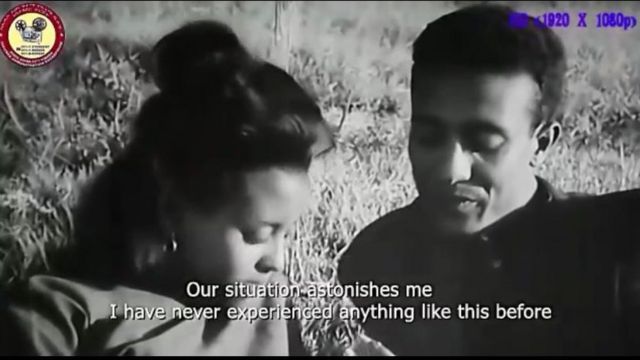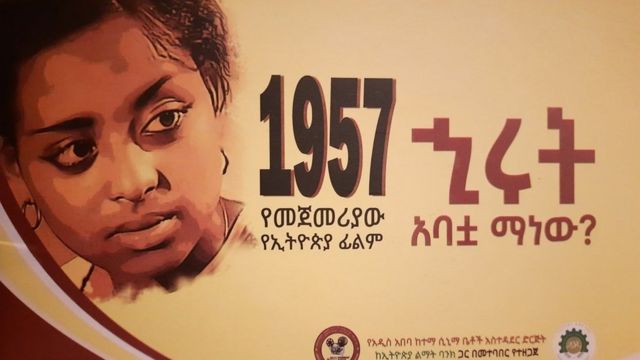"At first there were only books, newspapers and radios. Then there was television. Recently, there was a movie theater produced b...
"At first there were only books, newspapers and radios. Then there was television. Recently, there was a movie theater produced by the National Film and Advertising Association. "It's the first attempt. We feel it is appropriate to encourage the attempt."
This article was published by Addis Zemen newspaper on August 23, 1957. Excerpt from a film about the graduation of a film by critic Berhanu Zerihun.
"Who is Hirut's father?" Fifty-seven years after it was unveiled, it was digitally transformed at the Sheraton Hotel on January 5, 2014 by many.
Who is Hirut's father who set up the setting in Addis Ababa, Koka, Asmara? The story begins in the city of Nazareth [Adama].
Hirut, the daughter of a nobleman, once met her family at a concert venue in Nazareth with her family, a musician named Gugsa.
As Gugsa and Hirut spent some time in love, Gugsa was arrested and Hirut became pregnant.
In Ethiopia, where unmarried pregnancies were considered a major stigma in the 1950's, the alternative was to head to Hirut and head to Addis Ababa, Merkato.
A 57-year-old film explores the struggles of being employed by a bar in Addis Ababa.
The graduation ceremony took place on the evening of August 21, 1957, at the former Haile Selassie I Theater (National Theater). He said.
Speaking at the launch of the film, the author of the film, Ilala Ibsa, expressed his gratitude to Emperor Haile Selassie for attending the inaugural film.
"The main function of a film is that it can be likened to a mirror . Through a mirror , a person or a person can look at his morals and work throughout his life and correct his mistakes by correcting his mistakes . He can have a strong morale .
Who was Hirut's father born?
It was a time when fiction movies were widely seen in Addis Ababa in the 50's and 60's.
Ethiopian Cinema: The Socio -economic and Political Impacts of Imperial Era on the Development of Screen Media
They have agreed to produce films with Warner Brothers Seben Arts, a well-known brand in the film industry, and 20 Century Fox in Addis Ababa, Ambassador Haile Selassie I Theater, Adwa, Drive in Theater and Cinema Ras Cinemas.
The films will be screened after being approved by a body that evaluates whether they fit into the culture of the country.
Actors such as Anthony Quinn, Charlie Chaplin, Clint Eastwood, Frank Senatran, who were also very popular among Hollywood films, also influenced the young man's attire, speech, music, and lifestyle at that time.
For those who could not go to the cinemas and theaters, the introduction of Ethiopian television movies and series also increased its reach in the city.
The development of cinema culture at the time attracted the attention of Ethiopians and led to the production of the first Ethiopian novel and film production company.
Who is Hirut's father? Menelik claims that the writer Ilala Ibsa is a professional economist. The film is directed by the Greek Lambros Yucaris.
Founded by Ilala Ibsa and Lambrosros Ucaris, he founded a 14-member company, Country Film and Advertising, and became the CEO of Ilala Ibsa.
The company originally planned to make the film 'David III', which was written by then-Prime Minister Mekonnen.
Who was Hirut's father? All the technicians were European. Both editing and filming were done by the Italian Film Laboratory and produced 25 copies.
Menelik quotes an article in the Addis Zemen newspaper as saying that the national film and advertising company borrowed 200,000 birr from the Development Bank to build the film. According to Aboneh, the film cost 140,000 birr ($ 70,000 at the time).
How was the movie in its day ?
To find out who Hirut's father was in the city, especially in the area where he was able to reach the arts, the current political situation. It is important to understand the social and global context.
The 1950's and 60's saw a resurgence of student activism, the emergence of African nations, the establishment of the Organization of African Unity, the expansion of culture and the arts, and the return of educated people abroad.
It was a time when the concept of modernization was so prevalent and plans to modernize Ethiopia, how to build the country and the economy were being written by Menen, Addis Reporter, Addis Review, Addis Zemen, Today's Ethiopia.
History has it that many of the pioneers of literature, theater, film, music, and the arts came to study abroad in an effort to bring modernity to Ethiopia.
Although their main goal is to lift Ethiopia out of poverty and modernize, they have also demonstrated that their main mission is to withstand the pressures of the West, which is seen as a dominant ideology. It was then that Hirut's father graduated.
According to Abuneh Ashagre, director of the first 35mm film Guma, quoting Papatikus, Emperor Haile Selassie withdrew from the film.
"Ethiopia has a very important history and how can a prostitute [sex] make history," he said in a statement.
Even so, Emperor Haile Selassie received the film star Akale Amenshewa at his palace and presented her with a cash and gold bracelet.
Following the release of the film, there was a heated exchange between the film critic Berhanu Zerihun and writer Ilala Ibsa in the Addis Zemen newspaper.
Menelik argues in his August 1957 study of New Age that Berhanu did not bring a new and consistent story and that the message and theme to the audience lacked clarity.
"The whole point of the story is not clear. The story, although it may not seem boring, is normal. Yeshi, Getachew Debalke, Wondelate, Anu Agonafer, Bete, Prostitute
Hirut criticized her opening a bar as a bartender and saying, "I have to get out of this life," and citing her wealth as "a way for many women to grow up."
It should be noted that while writers and scholars at the time understood oppression, they also had limited views on the role of women.
Although many women's rights movements have been revived in many countries, Dr. Elizabeth Wolde Giorgis ' article in Gender and Representation in Ethiopian Art and Media states that this is not the case.
Among those who wrote at the time were women who benefited from office work;
When we look at Zerihun's article, the idea that "the film is appealing to women" seems to stem from the fact that women are inspired by the film to enter the profession, as it is a center for women's self-determination, protection, and moral and cultural issues.
In response, Ilala Ibsa wrote: "The message of the story is not clear. The film encourages promiscuity.
"The message of the story is to work without thinking, to the extent of ignorance, to the detriment of prostitution, to the dissatisfaction of the spirit, to the dissatisfaction of the body, to the disgrace of humiliation." If it does not save her from being humiliated, in our opinion, this will break the morale of the people in this profession, rather than insults and slander.
According to Ilala, Hirut's story shows that the story of Hirut does not encourage sex and has touched the hearts of many.
"As we have heard, there are very few women who come out of the theater with their headscarves in their hands. ? " They ask.
Abebech Ejigu and Alemayehu Assefa played the lead role in the film.
A little about the actors
According to Menelik, Abebech Ejigu, who represented Hirut, won the women's beauty pageant in the 1950s.
Alemayehu Assefa played the role of Gugsa, who lived in Germany for five decades and recently passed away.
While in Ethiopia, Alemayehu served as a pilot and transferred to the Civil Aviation Licensing Institute.
Is Menelik Menen's magazine changing the culture of marriage as the two lead actors get married? According to an article published in 1958, Hirut's father, who is the father of the actress, rejected the family's choice to marry their children.
Abebech Ejigu Hirut came from Germany to watch the film in Addis Ababa when her father appeared in 1985.
Menelik's study also found that Menelik II, a leading figure in Ethiopian music, was one of the leading figures in Ethiopian music.
In addition to Narcissus Nalbandian, Tesfaye Gebre, who is best known for his songs "Peace for Ethiopia, Sport for Health" and which has made a name for himself in Italy, is also featured in the film.
After the film was released for four years, the company was in debt for a long time because it could not afford to pay for the film.
Development Bank canceled the debt and donated it to the Ministry of Culture and Tourism in 2006.
According to writer Ilala Ibsa, like Adwa, Maychew planned to film historical battles but failed.
According to Menelik's study, in 1961, the company came from the University of Hungary, where he was studying. But after some effort, things did not go as planned.
Following the Derg's rise to power, the National Film and Advertising Association disbanded.
Menelik explains that the film, which is well-known for its reading and research, has recently been shown at the Sheraton, and that it has become a digital copy with some quality defects.
Menelik explains that when it comes to digital transformation, it is often the use of outsourced laboratories. Menelik's father, who is currently on digital copy, complained to the Addis Ababa Cinema Administration about the poor quality of the film.
Menelik plans to show the film in other Ethiopian cities, abroad, in Greece and in the United States.
The beginning of cinematic history by a few
Ethiopia is one of the pioneers in the field of cinema technology.
Cinema was introduced in Ethiopia three years after the first European cinema was introduced in France in 1895 by the Louis Lumier brothers, a world-renowned cinema maker.
Following Adwan's 1896 victory, France, Britain, and Germany competed to strengthen their diplomatic ties with Menelik. Historians note that many foreigners, both private and official, began to flock.
The first film, 'Al tempo di Menelik', written by a Greek man at the time, 'Al tempo di Menelik', appeared on April 1, 1989, in a Greek projector.
The chosen film is the story of Jesus Christ.
After such recognition, the first cinema was opened in 1898 by a Frenchman from Addis Ababa, Algeria. The cinema was also linked to the Hotel de France.
Charles Martel, a French army general who took a cinema that began with cinema in Europe in 1909, filmed the ill-fated Menelik Menelik, his dancers and his attendants in Harar, during his 'L'Abyssinie au temps de Menelik' during the 24 minutes of Menelik's Abyssinia. Research text can be understood.
Abuneh also wrote that this is the first film to be shot on Ethiopian soil. Since then, a number of documentaries have been produced by French filmmakers.
The first Ethiopian documentary was made in 1920 by Europeans. The first cinematographer, Tedla Tesema, filmed the Queen's story in a 16mm black and white film. Abuneh recorded that the film was silent.
Following the Italian occupation of Ethiopia, not only cinemas were made, but also films about Ethiopia were made.
Western filmmakers portrayed Africans as submissive, barbaric, cruel, and sometimes inhuman. Colonial propaganda focused on highlighting the differences between indigenous and civilized whites who had no culture or history.
'The Cross of the South' is an Italian drama made in the 1930s. The text of the film shows Italy's victory over Abyssinia.
History has it that during the Italian occupation of Ethiopia, it was one of the eight series of films produced by the Italian African Empire during the Fascist era.
The film is a propaganda tool designed to support fascist policies and depicts romantic relationships between races.
It is said to have been recorded in Oromia, although it does not mention a specific location in the Trenia studio in Tuscany and in Ethiopia.













No comments